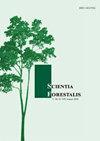Wood annual average increment and K, Ca and Mg mineral compartments in soils cultivated with eucalypt
IF 0.4
4区 农林科学
Q4 FORESTRY
引用次数: 0
Abstract
Forestry continuously grows in Brazil and it increases the concerns among planted forest companies regarding sustainable production. Knowledge about soil mineral reserves and nutrient release kinetics may introduce an opportunity to optimize fertility management, improving production. The objectives of this study were to evaluate the contents of K, Ca and Mg in the reserve, non-exchangeable, exchangeable and available soil compartments and the nutrient release speed, as well as their correlations and effects on eucalypt productivity. Soil samples were collected from eucalypt plantation sites at the state of Rio Grande do Sul, Brazil, comprising seven soil classes. The contents of K, Ca and Mg were determined in sulfuric digestion extract, boiling nitric acid, ammonium chloride, Mehlich-1 and potassium chloride. Nutrient release kinetics were evaluated per Sparks (1989), while CMPC Celulose Riograndense provided the wood volumetric annual average increment (AAI) from the eucalypt plantations. The contents of K, Ca and Mg varied between compartments and depths and were concentrated in the reserve compartment, indicating the importance of this compartment for midand long-term nutrient supply. Most compartments of K, Ca and Mg showed significant correlation; and eucalypt wood productivity (AAI) correlated significantly with the different compartments in both depths, mainly with the reserve compartment and release kinetics expressing their relevance for productivity; in particular for the case of long-cycle plant species, where nutrient release at intermediate and long terms is important.桉树栽培土壤木材年平均生长量和钾、钙、镁矿物区室
巴西的林业持续增长,这增加了人工林公司对可持续生产的关注。了解土壤矿产储量和养分释放动力学可以为优化肥力管理、提高产量提供机会。研究了桉树后备区、非交换区、交换区和有效区K、Ca、Mg的含量和养分释放速度,以及它们之间的相关性和对桉树生产力的影响。土壤样本从巴西南里奥格兰德州的桉树种植园收集,包括七个土壤类别。测定了硫酸消解浸膏、沸腾硝酸、氯化铵、梅利希-1和氯化钾中钾、钙、镁的含量。根据Sparks(1989)评估了养分释放动力学,而CMPC Celulose Riograndense提供了桉树人工林的木材体积年平均增量(AAI)。钾、钙、镁的含量因室和深度的不同而不同,且主要集中在储备室,说明储备室对中长期养分供应的重要性。钾、钙、镁的大部分区室呈极显著相关;桉树木材生产力(AAI)与两个深度的不同隔室显著相关,主要与储备隔室和释放动力学表达其与生产力的相关性;特别是对于长周期植物物种,其中中期和长期的养分释放是重要的。
本文章由计算机程序翻译,如有差异,请以英文原文为准。
求助全文
约1分钟内获得全文
求助全文
来源期刊

Scientia Forestalis
Agricultural and Biological Sciences-Forestry
CiteScore
1.00
自引率
0.00%
发文量
39
期刊介绍:
Scientia Forestalis is a scientific publication of the IPEF – Institute of Forest Research and Studies, founded in 1968, as a nonprofit institution, in agreement with the LCF – Department of Forest Sciences of the ESALQ – Luiz de Queiroz College of Agriculture of the USP – São Paulo University. Scientia Forestalis, affiliated to the ABEC – Brazilian Association of Scientific Publishers, publishes four issues per year of original papers related to the several fields of the Forest Sciences.
The Editorial Board is composed by the Editor, the Scientific Editors (evaluating the manuscript), and the Associated Editors (helping on the decision of acceptation or not of the manuscript, analyzed by the Peer-Reviewers.
 求助内容:
求助内容: 应助结果提醒方式:
应助结果提醒方式:


